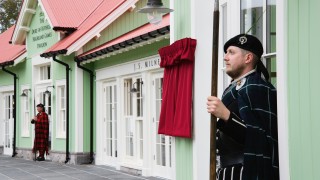Journal 1 February 2019
Utilising sustainable materials in modern architectural construction
Is the key to modern construction a return to vernacular architecture and sustainable materials?
Long before concrete and steel became the construction industry’s go-to materials, humans very successfully relied on easy-to-source natural products to build homes. Wood has been used as a building material for thousands of years. So too have stone, mud (in Ireland, homes have long been made from sod), clay, sand, grass and, among Inuit populations, snow. Two thousand years ago, the Chinese used rammed earth to build homes along the Silk Road. Remnants still stand.
The natural materials we built with were always locally available, which ensured production was sustainable. But over the past century we have come to rely on materials that require import, sometimes from great distances. Today, concrete and steel are distributed all over the world. That’s costly, and environmentally damaging. The concrete industry is responsible for producing up to five per cent of man-made C02 emissions worldwide, according to a report by the World Business Council for Sustainable Development. “We need to look much more critically at materials that use high levels of fossil fuels and are transported over large distances,” says Ben Bolgar, Senior Director at The Prince’s Foundation.

Increasingly, traditional materials like wood are creeping back into modern architectural practice, and they are being used in new and exciting ways. But just as architects are embracing natural materials, so too are they returning to vernacular architectural techniques – centuries-old construction methods that are specific to a particular people or region, and are often sustainable. Rising concern about climate breakdown has encouraged architects to both source materials locally and adapt regional styles and construction techniques within a modern context, reducing the reliance on imported materials and unsustainable construction techniques, while retaining provincial heritage. “The holy grail is to design modern buildings using traditional materials and techniques wherever relevant,” says Bolgar.
In 2001, HRH The Prince of Wales founded an organisation, the International Network for Traditional Building, Architecture and Urbanism (INTBAU), to help ensure that traditional materials and techniques are re-adopted by the construction industry. The organisation (a sister charity to The Prince’s Foundation) now has a presence in 32 countries, including Australia, Germany, India and Afghanistan. “We describe ourselves as a global network dedicated to creating better places to live,” says Harriet Wennberg, INTBAU’s Executive Director. “In Poland, that might mean working with architecture students to increase awareness of how to design more sustainably. In Morocco, it means addressing the fact that [the use of] rammed earth is dying out.”
Much of INTBAU’s work focuses on understanding how local vernaculars can be used to tackle contemporary building and sustainability issues. “Everywhere in the world we’re dealing with the impact of globalisation and the loss of local identity, rapid urbanisation, mass migration to cities, and climate change,” says Wennberg. But she believes architects are becoming “a lot more conscious” of the benefits of “using the materials of a place that can respond to the local climate and context”. In hyper-developed countries, employing vernacular architecture is often a choice. But in less developed countries, it can be essential to survival. “In Pakistan, architects are doing extraordinary work with earth, bamboo, lime and mud to build housing that is earthquake resistant and flood resilient,” says Wennberg. These are materials that are readily available, cheap and effective to use, and easy to maintain.
Alejandro Garcia Hermida, who heads INTBAU’s Spanish chapter, talks of a “growing concern about the loss of traditional craft, local identity, and the damage new developments are causing on the environment.” But recently he has noticed first-hand a rising demand for vernacular architecture. “Away from big cities, 90 per cent of people want a traditional design for their home,” he says. But there is a problem: often there are very few craftsmen with the necessary skills to provide the work, and their knowledge is rarely passed on. To help fix that problem, INTBAU Spain has developed a directory through which the public can locate artisans skilled in specific vernacular crafts. “That’s one of our main aims: to raise the awareness of this problem, and to try and fix it.”
That is also a primary mission of The Prince’s Foundation’s education programme, which offers short courses in traditional craft, as well as higher education courses run in partnership with institutions including the University of Oxford. This year, students have enrolled to develop skills in stone masonry, joinery, blacksmithing, bricklaying, lime plastering, thatching, and pargetting – a kind of ornamental plasterwork once popular in the East of England. The Foundation is training the next generation of international craftspeople – students come from all over the world – but it is not only providing them the skills to work within the heritage sector. “It’s really important that these skills and trades are utilised in the production of new builds,” says Simon Sadinsky, The Prince’s Foundation Deputy Executive Director of Education. “A lot of what we teach is about repair and maintenance, but it’s also about placing students in live new-build situations, where they are able to use their traditional skills in a modern context.”
Sadinsky agrees with Hermida – in order for the construction industry to evolve, there needs to be an abundance of experts in specific vernacular fields. “Given the speed of urbanisation, it’s increasingly important that there are craftspeople available to do the work,” says Sadinsky. “A third of craftspeople working in the sector are nearing retirement, and two thirds are currently not passing on their skills or knowledge.” Sadinsky argues education is key. “A big part of this is raising awareness of the types of opportunities available – understanding that there are some really interesting high-skilled trades in the arts.”
And it’s not just craftspeople that require education; architects do, too. “In order to create sustainable communities there needs to be a greater interaction between disciplines,” says Sadinsky. “There is often a disconnect between those practising craft and those engaged in the fields of architecture and urbanism.”
This is where The Prince’s Foundation’s higher education courses become important. Vito de Bellis, who took the Foundation’s MA Sustainable Urbanism course in 2015, says that “often as an architect, you focus only on the buildings, while at The Prince’s Foundation, you learn how to broaden your view.” De Bellis has a background in architecture, but enrolled at The Prince’s Foundation in order to “learn more about sustainable urbanism by practicing it”. “An important part of the MA is the industry placement,” he says, “which means I can study and then put that knowledge directly into practice.”
Sadinsky believes this kind of hands-on education is crucial. “These days, architecture students will not necessarily have exposure to the plurality of their practice, working alongside craftspeople, how materials work, and how they inform the built form,” he says. “That’s a core principle of what we’re delivering.”
“The 21st century will be the age of wood”
Those kinds of architects do already exist. In 1997, British architects Anthony Thistleton and Andrew Waugh established Waugh Thistleton Architects – a practice founded on an architectural approach rooted in science, technology, and an understanding of materials and their inherent uses. From the outset, the pair were keen to better comprehend how buildings were made, why certain materials were more effective than others, and what impact the use of different materials had on cost, a project timeline, and the environment. “Unless you understand how a building is constructed, you can’t achieve the best results,” says Thistleton.
Waugh Thistleton are emblematic of a new group of architects that place sustainability at the heart of their practice. In 2008, the pair began building a nine-storey London tower block constructed almost entirely out of cross laminated timber (CLT), a new kind of wood product in which layers of timber are glued together at perpendicular angles. Thistleton and Waugh saw in CLT an opportunity to reinstate timber’s position as a valid modern construction material. They knew it was as effective as concrete, but also that it was lighter, cheaper to produce, quicker and easier to build with, and less troublesome to import. “We immediately thought, this is a completely different approach,” says Thistleton. “CLT panels are produced off-site, they’re erected very quickly, and the wood you’re using has actually absorbed carbon from the atmosphere, as opposed to concrete and steel, which contain large amounts of embodied energy.”

In 2003 the pair convinced a major developer that the nine-storey residential tower block it was about to build should be constructed out of CLT. “We told them it would be cheaper,” says Thistleton. That was true, but it was also far better for the environment. And so the UK’s first tall urban housing project built entirely from pre-fabricated solid timber was erected.
There are now wooden skyscrapers in Norway and New Zealand. The world’s tallest timber building is currently under construction in Vienna, Austria. (Named the HoHo tower, it will be 24 storeys high.) Architects like Waugh and Thistleton are very seriously beginning to herald a great timber renaissance. “We would call the 20th century the concrete age,” says Thistleton. The 21st, he hopes, will be the age of wood.
In the West, vernacular architecture can be considered staid and old-fashioned, embraced by older generations and dismissed by the young. But Thistleton, Wennberg and Hermida all argue that’s not the case. “Some of the most fundamental elements of tradition are inherently modern,” says Wennberg. “If there’s a system that makes working in rammed earth easier, of course, you’re going to experiment with it.” Wennberg considers this a marriage of traditional skills and modern technology. “Techniques have to constantly evolve. But in order for that to happen, you need people who are still speaking the language.”
Wennberg envisions a successful future for vernacular architecture. “My impression is that the younger generation isn’t the one that needs convincing,” she says. “These concepts are an extension of hipster culture, where you want what you eat, drink, and wear to be made locally because it makes them feel more authentic. Why would this not apply to buildings too? At architecture schools around the world we are seeing a big demand for learning these types of skills, understanding building traditions, and getting to work with your hands.”





